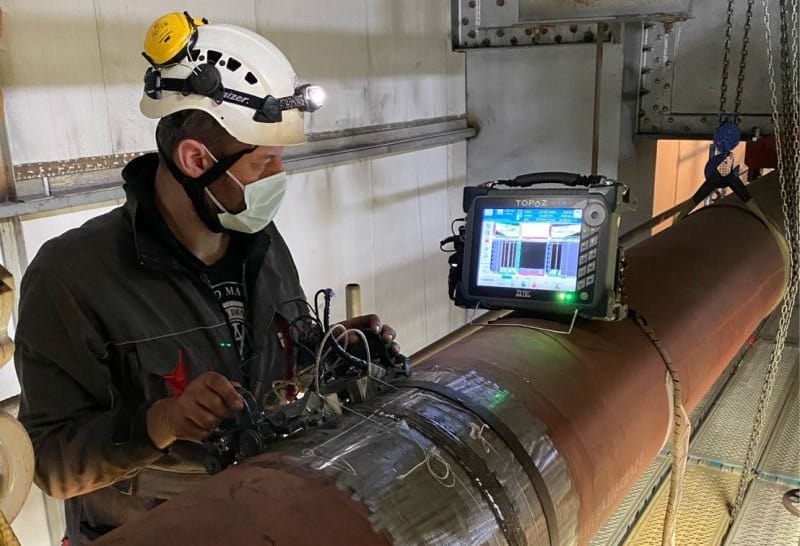Vital Pipe Welding Examination Tips for Quality Control
In the world of pipe building and construction, the stability of welds holds vital value to guarantee the safety and effectiveness of the entire system. From natural gas to refined oil items, pipes develop the lifeline of various sectors. Just how can one ensure the quality of these welds that attach the pipe sections? The solution hinges on precise assessment methods and adherence to stringent quality control standards. By recognizing the necessary pipeline welding inspection ideas, professionals can avoid prospective risks, reduce expensive repairs, and promote the dependability of these critical frameworks.

Significance of Welding Inspection
Welding assessment plays a crucial duty in guaranteeing the architectural integrity and safety and security of pipe systems. By diligently examining welds, examiners can determine any flaws or blemishes that could jeopardize the integrity of the pipeline. These examinations are vital for preventing leakages, ruptures, and other possibly catastrophic failures that might cause environmental damage, monetary losses, and also death.
The significance of welding inspection can not be overstated, as the top quality of welds straight impacts the general efficiency and long life of the pipe. Via non-destructive testing methods such as visual assessment, ultrasonic testing, radiography, and magnetic particle testing, examiners can identify flaws that may not be visible to the naked eye. By determining and resolving these concerns early on, welding inspection assists to make certain that pipes meet industry standards and regulatory requirements.
Ultimately, welding inspection is an important element of quality control in pipeline upkeep, repair work, and building (Pipeline Welding Inspection). By upholding strenuous assessment requirements, market professionals can minimize dangers and support the safety and security and reliability of pipeline systems
Common Welding Flaws
Among the difficulties faced in pipe welding, typical problems can considerably impact the architectural integrity and performance of the bonded joints. Some of one of the most common welding problems consist of lack of blend, porosity, fractures, incomplete infiltration, and misalignment. Absence of combination takes place when there is insufficient bonding between the weld metal and the base steel, causing a damaged joint. Porosity, defined by gas pockets within the weld, can lower the stamina and make the weld susceptible to deterioration. Cracks in the weld can circulate over time, endangering the structural honesty of the pipeline. Insufficient penetration happens when the weld steel does not fully permeate the joint, causing a weak bond. Misalignment, where the weld grain is not correctly focused, can lead to anxiety focus points and possible failing. Finding and addressing these usual issues with detailed assessment and quality assurance processes are necessary for making certain the dependability and safety pop over to these guys and security of pipe welds.
Assessment Strategies for Pipelines

Non-destructive screening (NDT) methods such as radiographic screening, ultrasonic testing, magnetic fragment testing, and fluid penetrant testing are frequently used in pipeline welding assessment. Aesthetic evaluation is additionally vital in pipe welding to identify any kind of visible problems or discontinuities. Furthermore, computerized evaluation techniques using advanced modern technologies like robotics and drones are significantly being employed to improve the performance and precision of pipeline assessments.
Ensuring Quality Control Standards
To promote stringent quality control requirements in pipeline building and construction, careful adherence to established market protocols and standards is vital. Quality guarantee in welding processes needs a comprehensive method encompassing my link numerous stages of pipeline building and construction. Guaranteeing the top quality of welds includes using qualified welders, correct welding procedures, and adherence to sector criteria such as those set by the American Oil Institute (API) and the American Society of Mechanical Engineers (ASME) Inspection and testing play an essential role in confirming the integrity of welds, with methods like non-destructive screening (NDT) being essential for identifying potential flaws. Furthermore, keeping comprehensive documents throughout the welding procedure is important for traceability and top quality control purposes. Executing a durable top quality monitoring system that includes routine audits and evaluations can better enhance the general quality control standards in pipeline welding. By prioritizing adherence to these requirements, stakeholders can make certain the integrity and safety of pipeline systems for the long term.
Preventing Costly Repair Work
Given the vital value of keeping stringent quality assurance requirements in pipeline building, an aggressive strategy to preventing costly repair services is crucial. Regular maintenance checks and monitoring of ecological factors that could impact the integrity of the pipeline are also crucial in preventing costly repairs. By investing in preventative measures and focusing on top quality guarantee at every phase of the pipe welding process, business can reduce the risk of expensive repairs and ensure the lasting integrity of their facilities.
Final Thought
Finally, adherence to appropriate welding examination strategies is necessary for making sure the high quality and integrity of pipelines. By recognizing typical welding problems and implementing thorough examination procedures, costly repairs can be protected against, and top quality guarantee criteria can be met - Pipeline Welding Inspection. It is vital for pipeline welders to prioritize inspection procedures to preserve the security and integrity of the framework they are dealing with
The relevance of welding assessment can not be overstated, as the visit this page top quality of welds straight impacts the total efficiency and durability of the pipe. Non-destructive screening (NDT) techniques such as radiographic screening, ultrasonic testing, magnetic fragment testing, and fluid penetrant testing are generally used in pipe welding evaluation. Aesthetic evaluation is additionally vital in pipe welding to determine any type of noticeable problems or discontinuities. Furthermore, automated assessment strategies utilizing innovative technologies like robotics and drones are significantly being employed to improve the performance and accuracy of pipeline examinations.In conclusion, adherence to appropriate welding examination techniques is necessary for making certain the quality and stability of pipes.